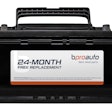Bosch brings their experience to bear in tackling diesel exhaust leaks.
Looking for leaks in a diesel particulate filter (DPF) or exhaust aftertreatment system can be frustrating and time consuming for technicians.
A common, yet dangerous and inefficient way technicians attempt to find leaks is by starting the engine to pressurize the system and then getting under the running truck to spray soapy water in the hopes that bubbles will form to help spot the leak. Ultrasonic listening devices are also frequently used in heavy duty leak detection, but the results can be unclear and imprecise.
Solving the problem of an elusive leak is critical because if aftertreatment systems aren’t sealed correctly, oxygen can enter the system and generate false sensor readings. Through these false readings, the system will incorrectly think it’s running rich or lean, putting the engine into over/under fuel mode to compensate. This will cause the DPF to plug prematurely and ultimately require early cleaning service, costing technicians and fleets time and money.
Conducting safe and efficient repair and maintenance on DPFs and other aftertreatment devices for heavy-duty trucks has become more complex with the release of the most recent clean air mandates. In addition, many components in modern trucks are difficult to reach and see, adding to the challenge of locating leaks quickly. Improper maintenance of these aftertreatment devices can result in trucks being out of service for days in a repair facility.
High-pressure leak testers or smoke machines provide a quick and efficient solution to finding leaks. A high-pressure leak detector uses regular compressed air to reach and maintain a variable pressure of up to 20 psi throughout the vehicle’s intake and exhaust system. Adapters fit the size and shape of the orifice to cleanly seal off intake and exhaust in different systems.
Since many upstream component leaks only appear under boost, compressed air is injected into the system through high-pressure leak detection with the engine safely off. A visual vapor is then introduced into the system which replicates the boost load of the running engine. The dense, highly visible vapor flows throughout the truck’s hoses, tubes and related components, escaping the system anywhere there is a leak present. This process makes it easy for technicians to see exactly where problems are located with accuracy and reliability.
A high-pressure leak tester or “smoke machine” built specifically for heavy-duty vehicles and systems can detect high-pressure and low-pressure upstream faults, pinpoint exact locations and precisely identify failing components. This can all be done in about 15 minutes, which is much quicker than the 45-120 minutes often associated with finding leaks through other methods such as using soapy water or ultrasonic listening.
Additional benefits of a high-pressure leak tester or smoke machine on aftertreatment devices for technicians include the following:
- Identify faults before they trigger excessive forced DPF regenerations or the engine going into de-rated operation.
- Locate unresolved upstream leaks (exhaust bellows, v clamps, exhaust manifold flanges, cracked tubing, compressed air charge leaks) to avoid premature plugging of the DPF.
- Easily pinpoint the root cause of DPF system problems and emissions cleansing catalyst issues associated with import trucks.
- Test the integrity of the air intake and exhaust systems without disturbing other components.
- Find exhaust leaks in minutes, preventing carbon monoxide vapors in the driver’s cabin area and inside bus passenger compartments.
In addition to finding leaks faster and more efficiently, a heavy-duty high-pressure leak tester or smoke machine such as the Bosch HPT 500 High-Pressure Leak Tester can greatly reduce diagnostic time and help eliminate come-backs. It can quickly locate leaks in turbo/boost, charge air cooler, exhaust system, wind and water, cabin, intake system, seals, gasket, hoses, fittings and more.
After using a high-pressure leak tester to find leaks, a quality heavy-duty scan tool can be used to look for codes that are causing the truck to run in de-rate mode. A portable diagnostic tool like the Bosch HDS 200 can easily be used for mobile truck repairs.
With preventative maintenance using a high-pressure leak tester, locating leaks can be a quick process instead of a major repair problem in the shop or a breakdown on the road. Using a leak tester during regular maintenance can prevent problems and allow for fixes before leaks become a major issue that cause lost time and money for a fleet.










